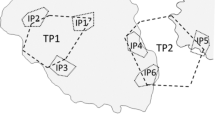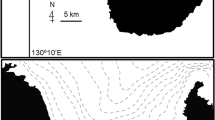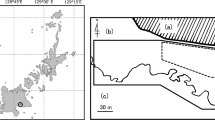Abstract
The endangered Japanese bagrid catfish, Pseudobagrus ichikawai, is typically nocturnal, emerging from shelters, such as crevices along the shore, at sunset to actively forage in open areas throughout the night with short-term movements of up to 40 m (except for mature males). Just before sunrise, individuals return to their shelters, from which they rarely emerge in daytime. Mature males (3 years-of-age or older) are found only in the vicinity of their shelters of during both day and night, which they defend with strong territorial behaviour. The restricted reproductive resources (shelters) probably severely limit the population size and reproduction in this species.








Similar content being viewed by others
References
Allan JD (1995) Stream ecology. Chapman & Hall, London, 388 pp
Arrington DA, Winemiller KO (2003) Diel changeover in sandbank fish assemblages in a neotropical floodplain river. J Fish Biol 63:442–459
Bhat A (2003) Diversity and composition of freshwater fishes in river systems of Central Western Ghats. India Environ Biol Fishes 68:25–38
Boujardt T (1995) Diel rhythms of feeding activity in the European catfish, Silurus glanis. Physiol Behav 58:641–645
Britz PJ, Pienaar AG (1992) Laboratory experiments on the effect of light and cover on the behavior and growth of African catfish, Clarias gariepinus (Pisces, Clariidae). J Zool 227:43–62
Burgess WE (1989) An atlas of freshwater and marine catfishes. T.F.H. Publications, Neptune, pp 784
Dahl J, Greenberg L (1996) Impact on stream benthic prey by benthic vs drift feeding predator: a meta-analysis. Oikos 77:177–181
Fraser DF, Gilliam JF, Albanese BW, Snider SB (2006) Effects of temporal patterning of predation threat on movement of a stream fish: evaluating an intermediate threat hypothesis. Environ Biol Fishes 76:25–35
Helfman GS (1978) Patterns of community structure in fishes: summary and overview. Environ Biol Fishes 3:129–148
Helfman GS (1993) Fish behaviour by day, night and twilight. In: Pitcher TJ (ed) Behaviour of Teleost Fishes 2nd edn. Chapman & Hall, London, pp 478–512
Hossain MAR, Batty RS, Haylor GS, Beveridge MCM (1999) Diel rhythms of feeding activity in African catfish, Clarias gariepinus (Burchell 1822). Aquaculture Res 30:901–905
Huryn AD (1998) Ecosystem-level evidence for top-down and bottom-up control of production in a grassland stream system. Oecologia 115:173–183
Kawanabe H, Mizuno N, Hosoya K (2001) Freshwater Fishes of Japan 3rd edn. Yamakei Publisher, Tokyo (in Japanese). p 720
Kobayakawa M (2003) Pseudobagrus ichikawai. In: Ministry of the environment (ed) Threatened wildlife of Japan––red data book 2nd edn––vol 4, Pisces––blackish and fresh water fishes. Japan Wildlife Research Center, Tokyo, pp 110–111 (in Japanese)
Martin P, Bateson P (1990) Measuring Behavior, an Introductory Guide. Cambridge Univ Press, Cambridge, p 238
Mashiko K (1979) The light intensity as a key factor controlling nocturnal action in the catfish, Pseudobagrus aurantiacus. Jpn J Ichthyol 25:251–258
Mashiko K (1981) Periodic nocturnal activities in the catfish Silurus asotus in captivity. Jpn J Ichthyol 28:148–156
Miyasaka H, Nakano S (1999) Effects of drift- and benthic-foraging fish on the drift dispersal of three species of mayfly nymphs in a Japanese stream. Oecologia 118:99–106
Nakano S, Miyasaka J, Kuhara N (1999) Terrestrial–aquatic linkages: riparian arthropod inputs alter trophic cascades in a stream food web. Ecology 80:2435–2441
Nikol’skii GV (1954) Special Ichthyology. (English translation by J.I. Lengy & Z. Krauthamer. 1961. Israel Program for Scientific Translations, Jerusalem. 538pp.)
Piet GJ, Guruge WAHP (1997) Diel variation in feeding and vertical distribution of ten co-occurring fish species: consequences for resource partitioning. Environ Biol Fishes 50:293–307
Sale PF (1979) Habitat partitioning and competition in fish communities. In: Clepper H (ed) Predator–prey system in fishery management. Sport fishing institute, Washington, DC, pp 323–331
Schoener TW (1974) Resource partitioning in ecological communities. Science 185:27–39
Vokoun JC, Rabeni CF (2006) Summer diel activity and movement paths of flathead catfish (Pylodictis olivaris) in two Missouri streams. Am Midl Nat 155:113–122
Watanabe K (1994a) Growth, maturity and population structure of the bagrid catfish, Pseudobagrus ichikawai, in the Tagiri River, Mie Prefecture, Japan. Jpn J Ichthyol 41:15–22
Watanabe K (1994b) Mating behavior and larval development of Pseudobagrus ichikawai (Siluriformes: Bagridae). Jpn J Ichthyol 41:243–251
Watanabe K (1997) Pseudobagrus ichikawai. In: Nagata Y, Hosoya K (eds) Circumstances in endangered Japanese freshwater fishes and their protection. Midori Shobo, Tokyo (in Japanese), pp 122–132
Watanabe K, Ito S (1999) Population size and distribution of Pseudobagrus ichikawai, an endangered bagrid catfish, in the Kawaura River. Jpn J Ichthyol 46:15–30 (in Japanese with English abstract)
Acknowledgements
I sincerely thank the late S. Watanabe and his family, and S. Ando for their help during the field work, S. Mori, M. Nagoshi and Y. Taki for invaluable advice and discussion, and the Fisheries’ Union of the Upper Reaches of the Tsubo River, the Board of Education of Minokamo City and Gifu Prefecture, and the Japanese National Agency for Cultural Affairs for providing permission for the study.
Author information
Authors and Affiliations
Corresponding author
Rights and permissions
About this article
Cite this article
Watanabe, K. Diel activity and reproductive territory of the Japanese bagrid catfish, Pseudobagrus ichikawai . Environ Biol Fish 81, 77–86 (2008). https://doi.org/10.1007/s10641-006-9173-6
Received:
Accepted:
Published:
Issue Date:
DOI: https://doi.org/10.1007/s10641-006-9173-6




